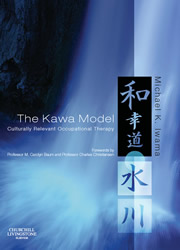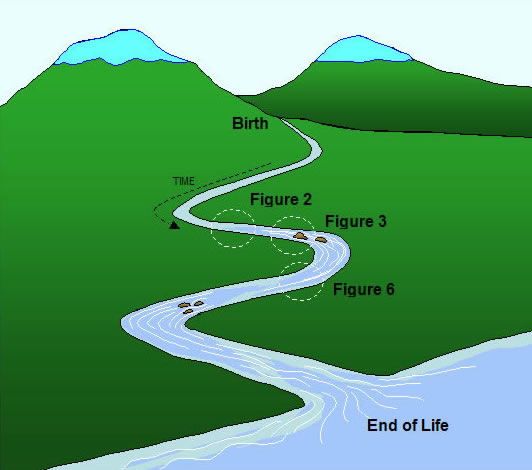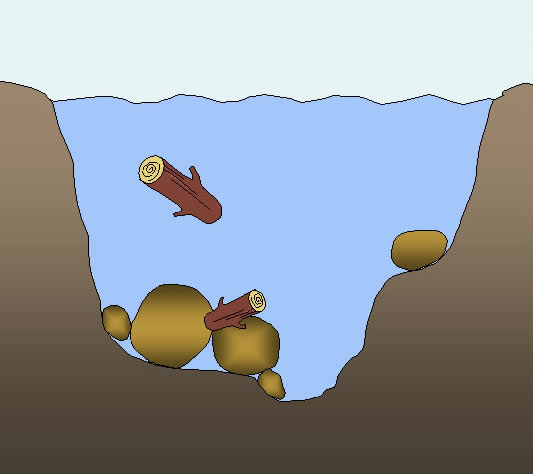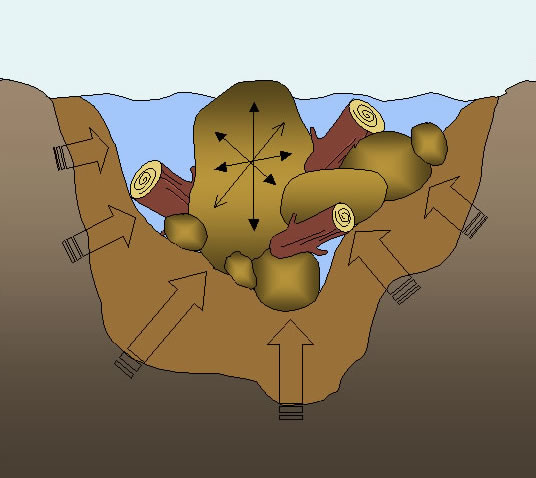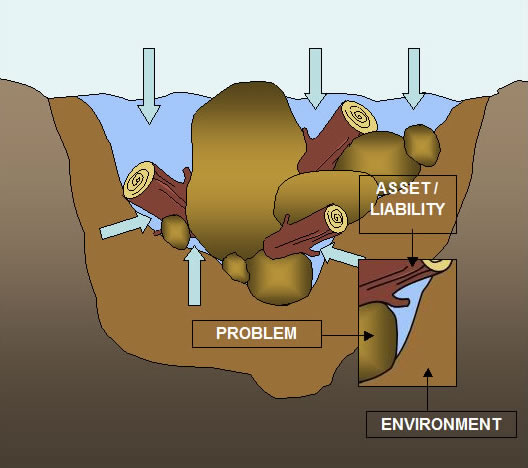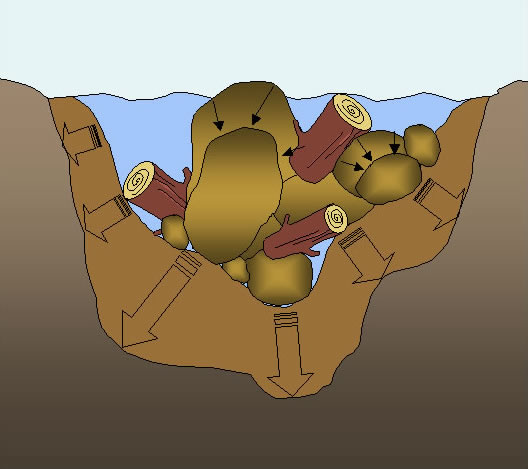The Kawa model attempts to explain occupational therapy’s overall purpose, strategies for interpreting a client’s circumstances and clarify the rationale and application of occupational therapy within the client’s particular social and cultural context.
Structure of the River as a Metaphor for “Life Energy” or “Life Flow”
The Kawa (Japanese for ‘River’) model uses the metaphor or image of a river as it occurs in nature as a symbolic representation of life. Instead of life being explained from an existential perspective, in which the self is the focus and ceded the most privileged position of the narrative, self is seen in, and treated in, context of all elements in the subject’s frame. The view that constructs doing, accomplishment, failure, well-being or disability, for example, as individual embodiments is but an illusion from this perspective. The context is seen to set certain conditions in which a particular action or occupation occurs. The surrounding social and physical environment can to a significant extent influence the meaning and value ascribed to an action or phenomena, as well as contribute to the definitions of what constitute optimal or undesirable states of being. In this way, the surrounding contexts are given much more credence in determining one’s state of being. The surrounding context can enable and disable people.
The complex dynamic that characterizes an Eastern perspective of harmony in life between self and context might be best explained through a familiar metaphor of nature. The river is employed as a symbol for the life course. It has its beginning at higher elevations and its termination somewhere, lower down along the course of time. Rivers can cease to flow by drying up, by being dammed by natural or man-made actions, by flowing into a terminal lake or into the vast sea. Wherever the river flows, the profound and complex inter-relation of other elements of nature become apparent. As other elements of nature participate in the life or flow of a river, so the river also participates in the other. Vital relationships form between all elements in a context/frame and a balance or ‘harmony’ comes into being. It is a balance that reflects the inter-related nature of the elements quite unlike the artificial, mechanical metaphor of the individual as a (mechanical) ‘system’ oriented to subdue and exert control over circumstance and an objectified environment.
Figure 1: Life is like a river, flowing from birth to end of life
Life is a complex, profound journey that flows through time and space, like a river (Figure 1). An optimal state of well-being in one’s life or river, can be metaphorically portrayed by an image of strong, deep, unimpeded flow. Aspects of the environment and phenomenal circumstances, like certain structures found in a river, can influence and effect that flow. Rocks (life circumstances), walls and bottom (environment), driftwood (assets and liabilities), are all inseparable parts of a river that determine it’s boundaries, shape and flow (Figure 2).
Figure 2: Cross section view of the early Kawa model showing the basic concepts in Japanese and in English
Mizu (water)
Mizu- is Japanese for ‘water’, and metaphorically represents the subject’s life energy or life flow. Fluid, pure, spirit, filling, cleansing and renewing, are only some of the meanings and functions commonly associated with this natural element. In the model’s introduction in various parts of the world removed from Japan, culturally specific interpretations or symbolic meanings of water have been apparent. What are your own symbolic understandings of water? The cultural meanings with which one views these concepts will have significant bearing on the utility of this model in one’s practice.
Just as people’s lives are bounded and shaped by their surroundings, people and circumstances, the water flowing as a river touches the rocks, sides and banks and all other elements that form its context. Water envelopes, defines and effects these other elements of the river in a similar way to which the same elements effect the water’s volume, shape and flow rate. When life energy or flow weakens, the occupational therapy client- whether defined as individual or collective can be described as unwell, or in a state of disharmony. When it stops flowing altogether- as when the river releases into a vast ocean, end of life is signified.
In a similar way to which water in its liquid state adopts its form from its container, people in many collective-oriented societies often interpret the social as a shaper of individual selves and groups. Sharing a view of the cosmos that rejects the rational separations of the surrounding world into discrete parts, collectively oriented people tend to place enormous value on the self embedded in relationships. There is greater value in ‘belonging’ and ‘interdependence’, than in unilateral agency and in individual determinism. In such experience, the interdependent self is deeply influenced and even determined by the surrounding social context, at a given time and place, in a similar way to which water in a river, at any given point, will vary in form, flow direction, rate, volume and clarity. The ‘driving force’ of one’s life is interconnected with others sharing the same social frame or ba (Nakane1970), in a similar way in which water touches, connects and relates all elements of a river that have varying effect upon its form and flow.
Torimaki: Kawa no Soku-Heki (river side-wall) and Kawa no Zoko (river bottom).
The river’s sides and bottom, referred to in the Japanese lexicon respectively as kawa no soku-heki and kawa no zoko, are the structures/concepts from the river metaphor stand for the client’s environment. Together they are referred to as torimaki. The torimaki are perhaps the most important determinants of a person’s life flow in a collectivist social context because of the primacy afforded to the environmental context in determining the experiences of self and subsequent meanings of personal action. In the Kawa model, the river walls and sides represent the subject’s social and physical contexts. The social context comprises mainly those who share a relationship with the subject. Depending upon which social frame is perceived as being most important in a given instance and place, the riversides and bottom can represent family members, pets (dearly loved and appreciated companions with whom people develop profoundly meaningful relationships) workmates, friends in a recreational club, classmates, etc. Deceased family members or friends whose memory exerts an influence on meanings in a person’s or group’s daily life, can and should be included here. Conversing with deceased loved ones might qualify a person for a psychiatric consult in a certain cultural interpretation of normal, but in the framework of the Kawa model, this can represent a legitimate, deeply meaningful human occupation. In certain non-Western societies like those of Japan, social relationships are regarded to be the central determinant, of individual and collective life flow.
Aspects of the surrounding social frame on the subject can effect the overall flow (volume and rate) of the kawa. Harmonious relationships can enable and complement life flow. Increased flow can have an agent effect upon difficult circumstances and problems as the force of water displaces rocks in the channel and even create new courses through which to flow. Conversely, a decrease in flow volume can exert a compounding, negative effect on the other elements that take up space in the channel (Figure 3). If there are obstructions (rocks and driftwood) in the watercourse when river walls and bottom are thickened and constricting, the flow of the river is especially compromised. As we will see, the rocks in this river can directly butt up against the river walls and bottom, compounding and creating larger impediments to the river’s usual flow. When applying the Kawa model in collectivist-oriented populations, these components and the perceptions of their importance are paramount.
Figure 3: Cross section view of a client’s Kawa showing the effect of river components on flow
Like all other elements of the river, these concepts are always interpreted in relation to the whole, taking into consideration all other elements of the subject’s context and their inter-relations/interdependencies. Occupational therapists have traditionally been concerned with a ‘holistic’ view of the client. Most therapists would be concerned if his or her role was limited in practice scope to assessing and treating pathology. Occupational therapists have long appreciated and concerned themselves with the social consequences affecting the client’s ability to engage in functional and meaningful daily activities resulting from a particular pathology.
Iwa (Rocks)
Iwa (Japanese for large rocks or crags) represent discrete circumstances that are considered to be impediments to one’s life-flow. They are life circumstances perceived by the client to be problematic and difficult to remove. Most rivers, like people’s lives, have such rocks or impediments, of varying size, shape and number. Large rocks, by themselves or in combination with other rocks, jammed directly or indirectly against the river walls and sides (environment) can profoundly impede and obstruct flow. The client’s rocks may have been there since the beginning, such as with congenital conditions. They may appear instantaneously, as in sudden illness or injury, and even be transient. If you reflect on your own life as a river, you may see a variety of rocks (of different sizes and shapes) in your river. Some of these rocks remain unremarkable until they butt up against certain aspects of the social and physical environment.
The impeding effect of rocks can compound when situated against the river’s sides and walls (environment). A person’s bodily impairment becomes disabling when interfaced with the environment. For example, the functional difficulties associated with a neurological condition can change according to the environmental context. A (physically) barrier-free environment can decrease one’s disability, as can social and/or political/organizational environments that are accepting and accommodating of people with disabling conditions. Auditory hallucinations become even more problematic in an congested social environment; sexual orientation can become more of a discouraging issue for a person in the context of a hostile and intolerant social context; being unable to walk becomes a problem when the laws do not require workplaces to be accessible by wheelchair; sexual impotence may be less of a problem until it involves a sexual partner (social environment).
Once the client’s perceived rocks are known (including their relative size and situation), the therapist can help to identify potential areas of intervention and strategies to enable better life-flow. The broader contextual definition of disabling circumstances necessarily brings into play the client’s surrounding environment. Occupational therapy intervention can therefore include treatment strategies that expand beyond the traditional medical patient, to his or her social network and even to policies and social structures that ultimately play a part in setting the disabling context. The Kawa model may assist the therapist in visioning the relationship between the client(s) and their context and help to clarify the targets of a more holistic occupational therapy practice.
Ryuboku (Driftwood)
Ryuboku is Japanese for ‘driftwood’, and represents the subject’s personal attributes and resources, such as: values (i.e. honesty, thrift), character (i.e. optimism, stubbornness), personality (i.e. reserved, outgoing), special skill (i.e. carpentry, public speaking) immaterial (i.e. friends, siblings) and material assets (i.e. wealth, special equipment) and living situation (rural and urban, shared accommodations, etc) that can positively or negatively affect the subject’s circumstance and life flow.
Like driftwood they are transient in nature and carry a certain quality of fate or serendipity. They can appear to be inconsequential in some instances and significantly obstructive in others- particularly when they settle in amongst rocks and the river-sides and walls. On the other hand, they can collide with the same structures to nudge obstructions out of the way. A client’s religious faith and sense of determination can be positive factors in persevering to erode or move rocks out of the way. Receiving a grant to acquire specialized assistive equipment can turn out to be the piece of driftwood that collides against a rock of financial debt, opening a greater channel for one’s life to flow more strongly. Traditionally, many of these matters were treated from an individual perspective and in genres of research such as psychology, these were treated more as individual embodiments rather than being located both inside the human being as well as in the environmental realm. Once again, the attitude demonstrated in this rendition of the kawa model here is that human phenomena and the ascription of meaning occur both inside and outside of the human body, in a broader, integrated frame.
Sukima (space between obstructions) where life energy still flows; the promise of occupational therapy
Now that the purpose of the metaphor of a river to depict a person’s life flow and situation is clearer, attention can be focused on the sukima (spaces between the rocks, driftwood, and river walls and bottom). These spaces are as important to comprehend in the client as are the other elements of the river when determining how to apply and direct occupational therapy. In the Kawa model, spaces are the points through which the client’s life energy (water) evidently flows. In an extreme sense, these are those factors that sustain the client’s hope of seeing a new day. For example, a space between a functional impairment such as arthritis (an Iwa/rock) and a social group or person (in the river sides and walls) may represent a certain social role, such as parent, company worker, friend, etc.
The spaces through which life flows, is representative of ‘occupation’, from an Eastern perspective.
Figure 4: Cross sectional view of several gaps in the client’s Kawa pointing to potential targets for occupational therapy interventions
Water naturally coursing through these spaces can work to erode the rocks and river walls and bottom and over time transform them into larger conduits for life flow. This effect reflects the latent healing potential that each subject naturally holds within themselves and in the inseparable context.
Spaces, then, represent important foci for occupational therapy. They occur throughout the context of the self and environs; between the rocks, walls and bottom, and driftwood. Spaces subsume the environment as part of the greater context of the problem and expands the scope of intervention to naturally integrate what, in the Western sense, would have been treated separately through the dualism of internal (pertaining to self and personal attributes) and external (environment constructed as separate and outside of the self). Spaces are potential channels for the client’s flow, allowing client and therapist to determine multiple points and levels of intervention (Figure 5). In this way, each problem or enabling opportunity is bounded by and appreciated in a broader context.
Figure 5: Cross sectional view of a gap in the client’s Kawa pointing to the importance of understanding the client’s context to set priorities for occupational therapy
The concepts and the contextual application of the Kawa model are by natural design, flexible and adaptable. Each client’s unique river takes its important concepts and configuration from the situation of the subject, in a given time and place. The definition of problems and circumstances are broad- as broad and diverse as our clients’ worlds of meanings. In turn, this particular conceptualization of people and their circumstances foreshadows the broad outlook and scope of occupational therapy interventions, when set in particular cultural contexts. “What is occupation, and what do occupational therapists do?” In some cultures, clients may understand and explain that: “occupation is life flow, and occupational therapists are enablers of people’s life-flow”. Such a simple and clear metaphor may be better comprehended than the standard textbook definitions that we all learned as students of occupational therapy.
Figure 6: Cross sectional view of a client’s Kawa. Occupational therapists, in partnership with their clients are directed to stem further obstruction of life energy/flow and look for every opportunity in the broader context, to enhance and maximize the client’s life flow
